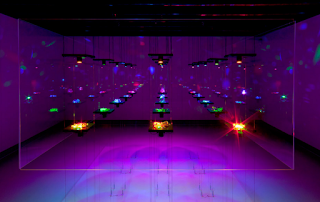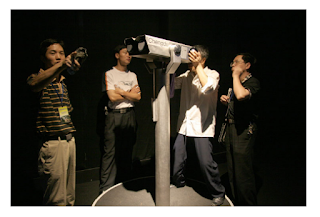University of Nevada, Reno
The Difference Between the Two:
A Comparison of Digital Media Artists
Adrianna White
Art 245
Professor Nicole Miller
December 19, 2016
Art is a mystery which has no real boundaries
for what the imagination can come up with and create; it is an ever-changing
form of expression. With the extreme advancements in technology, over the last
30 years, digital media as an art form is becoming increasingly more popular
throughout the art world. Thanks to these advancements, hundreds of artists,
including Erwin Redl and Maurice Benayoun, are making an appearance to show
what they are capable of in this expanding field. While there is a large amount
of similarity between digital media artists, such as Redl and Benayoun, and
upon further contemplation of their body of work, even the novice eye can
clearly see, these artists all have their own style.
With less than a 10-year span in their age
difference, Benayoun born 1957 and Redl born 1963, they have managed to have
overlapping careers in the art world. While Benayoun notably got his start in
film and video, Redl had a focus on electronic music and composition. Redl ‘hit’ the scene in 2002, whereas Benayoun
started to gain attention in the early 90s.
When considering these bits of information, one can infer that the
perhaps the socio-political climate, the culture of music, as well as the
regions of the world they were born in, would influence their artistic and
creative views; perhaps even give them each a unique perspective to what they
wished to express and that maybe media in a digital art form was the best
outlet for it.
Redl’s ‘Crystal Matrix’ (Figure 1-4) (Link 1) of
2011 draws the viewer in with a simply sound and light effect which matures and
escalates by giving more light, more sound – dramatic key strikes paired with
vibrant but at the same time subdued colors of red, blue, transitions of purple
– like the old-style tube televisions that sign off at the end of the broadcast
night - shown in shapes and shadow give way to what may almost be considered
cabaret in feel. Some may even desire a
set of roller skates just because of the memories that may arise. The point of view in terms of angle and
lighting changes when watching the video of it.
However, Crystal Matrix is an interactive installment which attendees
can maneuver and guide their own visual perspective. What one sees on one side, plus experiences
themselves, is certainly different from that of another attendee on the other
side of the installment. Each person who
views this specific art piece, due to different life experiences, will conjure
up different emotions, reactions, and possibly memories because there is no set
specific thing which Redl wishes to share to viewers, other than the sound,
lights, and patterns in which they all play off each other. It is very much the technological version of
cloud watching – where you never know, to one person, it is an elephant, and to
another, it could be a pirate ship!
The 2005 exhibit by Benayoun ‘Cosmopolis’ (Figure
6 and 7) (Link 2) is also an interactive expression. This particular exhibit has the visitor
utilizing virtual reality binoculars, much like the old viewers’ scene at local
piers and boardwalks, where the viewer may turn to look at the points of
interest – such as skylines, buildings, and shorelines among the local scenes.
Benayoun utilizes technology to allow the viewer to see beyond just the local
points of interest. Through the virtual
reality binoculars (Figure 5 and 8), the viewer has a 360-degree moving
panoramic of cities such as Berlin, Chicago, and Hong Kong, just to name a
few. The viewer does not rely solely on
their own life experiences when participating in this multimedia
exhibition. Cosmopolis forces the viewer
to witness ‘urban reality’ from five specific points of view. Thus, being guided by Benayoun to explore
what he considers to be a relevant issue.
Clearly, both Redl and Benayoun have something
to share with viewers of their individual art pieces. However, one allows the viewer to simply feel
the piece in terms of a full sight and sound experience which allows them to
utilize the more abstract nature of what they will see and feel based on
individual life experience which shapes their response versus the other which
has a socially conscious message he desires viewers to be faced with, to be
confronted with. Both pieces reflect, at
a minimum, the genres in which each artists started with. Redl showed his mastery of electronic music
and composition. Benayoun continued to create a mini film or short film, via
panoramic views of non-traditional tourist points of interest. From the
untrained eye, the artists seem to have nothing in common with the digital
media art that they create but utilize the same techniques to entrance people.
Additionally, both artists utilize movement
within each installation or exhibit. In the Crystal Matrix, the opening
sequence of sound with light has a small area of focus which draws the eye to
the immediate area which Redl has done with intent. He then expands upon this with a well-timed,
or choregraphed, sequence which then becomes almost 3 dimensional. The focus
shifts from floor, to outer segments, as if there are lights just off in the distance
as you are travelling a road way. From
there you realize there are floating crystals comprised of LED lights suspended
by what appears to be fish wire or cables.
The lights transition from that cabaret style of lighting to a stark
light which hits all sides of the installation. Redl uses not only the light,
but then the sound, which has changed from a drum roll to what sounds like
possible piano keys, thus alerting viewers that a change has occurred and
something is coming, but the when is not known.
Switch over to Cosmopolis with Benayoun, and
while there are no surprises to the fact that the viewing area is large, the
anticipation can be found in not knowing when the scenery will change from one
city to the next. There is no theatrical
suspense, as found in the dark, intimate lighting of Redl’s piece. The
spectator’s field of view is constantly lit, by what Benayoun refers to as
urban landscapes. True life, current
global concerns of sustainability and other urban problems are then presented
to the viewer. Additional information is
absorbed by the viewer through words, sounds and interviews edited in by the
artist in hopes that his message is received as it should be. That what they are seeing is of concern to all
people, near or far.
In today’s art world, and moving forward,
there is plenty of call for either expression in art. As they say, different strokes for different
folks. Art is subjective. Art through digital media is still
subjective. What one person sees or
feels upon viewing a piece of work, may never 100 percent be spot on with what
the creator had in mind. However, that
is hardly the goal of most artists. They
simply felt the need to create and to share whatever was driving them. What comes out, be it on canvas, through a
lens, or viewed with a click of PLAY, is what they were compelled to create and
to share. What we, as the viewer, take away after that, is entirely on us, and
beyond their control as all minds think differently.
Video Links
Link 1: https://vimeo.com/90913993, Crystal
Matrix by Erwin Redl
Link 2: https://vimeo.com/86717512, Cosmopolis by
Maurice Benayoun
Images
 |
Figure 1: Crystal Matrix
Erwin Redl
|
 |
Figure 2: Crystal Matrix
Erwin Redl
|
 |
Figure 3: Crystal Matrix
Erwin Redl
|
 |
Figure 4: Crystal Matrix
Erwin Redl
|
 |
Figure 5: Virtual Reality binoculars, Cosmopolis
Maurice Benayoun
|
 |
Figure 6: Cosmopolis
Maurice Benayoun
|
 |
Figure 7: Cosmopolis
Maurice Benayoun
|
 |
Figure 8: Virtual Reality binoculars, Cosmopolis
Maurice Benayoun
|
Bibliography
Benayoun, Maurice. "Maurice Benayoun's
art installations virtual reality and interactive art works." Maurice
Benayoun's art installations virtual reality and interactive art works.
Accessed December 19, 2016. http://www.benayoun.com/projet.php?id=31.
"Maurice Benayoun." Wikipedia.
Accessed December 19, 2016. https://en.wikipedia.org/wiki/Maurice_Benayoun.
Redl, Erwin. "Paramedia." Paramedia.
Accessed December 19, 2016. http://www.paramedia.net/installationpage/crystalmatrix.php.
"Erwin Redl." Wikipedia. Accessed
December 19, 2016. https://en.wikipedia.org/wiki/Erwin_Redl.
*Robertson, Barbara. "Without
Bounds." Without Bounds | Computer Graphics World. April 2009. Accessed
December 19, 2016. http://www.cgw.com/Publications/CGW/2009/Volume-32-Issue-4-Apr-2009-/Without-Bounds.aspx.
*Found via UNR KC resource website but also
found actual article online for citation purposes.














